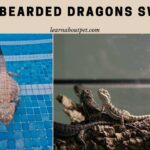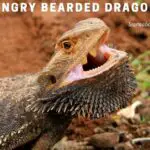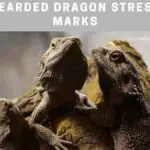You’ve always known that bearded dragons have two eyes, and that looks normal. Anyone who has bearded dragons must also say the same thing. I haven’t noticed this in my Bearded dragon on the first pet I brought it home but the next day I was thinking something is attached to my Bearded dragon suddenly. Then I researched and found this interesting fact.
Does Bearded Dragon third eye exist? The third eye of bearded dragons is called the Solar, Parietal, or Pineal Eye. This eye is a photo-sensory organ located at the top of its skull in a gray dot between the eyes. This third eye has a sense of light to detect an attack from above. This triggers hormone production and performs thermoregulation.
If you have three eyes, how about bearded dragon vision? Of course, you are curious about things related to the eyes of bearded dragons. Let’s read to the end about this.
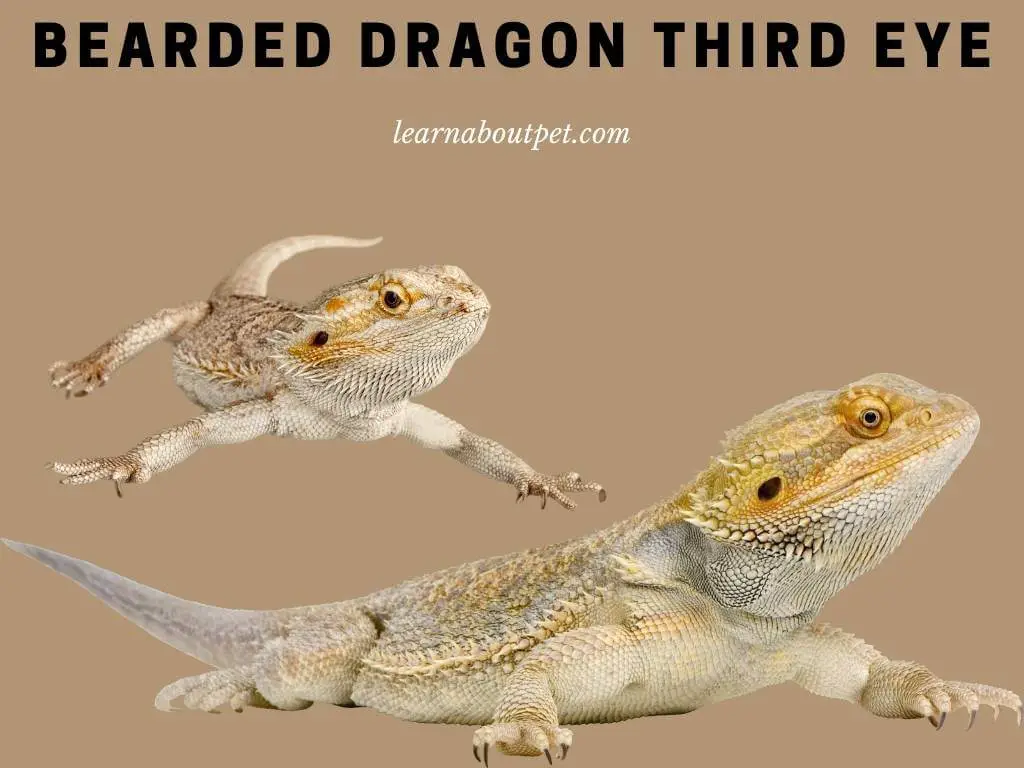
Bearded Dragon Eyes
It is essential to keep bearded dragon vision keen, healthy, and sharp. If the eyes do not get cleaned regularly, they could become infected with bacteria and fungus, which can cause serious health problems for your pet.
Suppose you notice any signs of infection, such as redness, swelling, or a foul smell around the bearded dragon third eye. In that case, you should immediately treat your bearded dragon with a specially formulated antibiotic eye cream.
The bearded dragon’s diet also plays a vital role in keeping his eyes healthy. Make sure you’re feeding him the suitable types of food. A balance of meat and vegetables is ideal. Providing your bearded dragon food rich in calcium and vitamins will help keep bearded dragon eyesight healthy.
How Many Eyes Do Bearded Dragons Have?
Bearded dragons have three eyes with two eyes on the side of the skull to see, while the bearded dragon 3rd eye is a solar eye for detecting light and sense if there is an attack from above.
Because bearded dragons’ eyes are on the side of their head, bearded dragons have better eyesight than humans. Meanwhile, the bearded dragon third eye, a gray spot at the top of the skull, is helpful for sensing changes in light, such as shadows or something passing by.
Do Bearded Dragons Have A Third Eye?
Yes, bearded dragons third eye are often called the parietal eye. In this way, the dragon’s perception of its environment was improved.
Also, they discovered that dragons with their third eyes tend to see better in dim light than dragons with no extra eyes. They also named this organ the “pineal gland.”
Do bearded dragons have a third eye that needs to properly care for? Because of their importance to the species and the owner’s comfort, you must learn how to properly care for your bearded dragon’s third eye. It can maintain its natural ability to sense danger and avoid injury.
You should also take special care to wash your bearded dragons’ eyes regularly with a mild solution of soap and water. Do not use any kind of cleaners on your bearded dragon’s eyes, as these can cause damage to its natural eye structure, as well as discomfort.
Bearded Dragon Third Eye
The bearded dragon third eye will issue a signal that connects directly to the brain’s optic center as if there is a sudden attack from a predator.
You can try to hold the bearded dragon’s head from above. If they dodge or defend themselves, that’s proof that their bearded dragon third eye works.
These pineal glands also produce hormones that are adjusted to the time of the day to help in wake and sleep cycles. The pineal complex, which will produce hormones, can also detect the time and season to influence thermoregulation.
Bearded Dragon Third Eye Covered
When pet owners find out about “do bearded dragons have a third eye,” they also learn why bearded dragons are so scared when we take them outside, and many birds roam around, or planes pass by.
It’s a bearded dragon third eye reaction that detects a thread from above, even though it’s just a shadow created from a distant object.
If you want to take your bearded dragons outside, make sure the bearded dragon third eye is covered with your hand or something else to reduce their sense of being exposed to light outside. Because if they live in captivity, there will be little threat because you are always watching them.
Bearded Dragon Third Eye Close Up
The third eye is a spot located behind the bearded dragon’s head covered in velvet-like skin. It is a sensitive area, and when you touch it, you might feel a slight tingle.
However, when you look at the bearded dragon third eyelid itself, there is a gray spot in the middle of the top skull, and it looks like a small hole even though it’s not like the original eyes.
It would be better if you leave the lights off while the bearded dragons sleep because the bearded dragon third eye also needs a dark room to sleep well. Meanwhile, from morning to evening, white light is needed for their body’s metabolism and to produce hormones that match the biological clock.
Bearded Dragon Eye Color
If you are not familiar with these reptiles, you must know that the bearded dragon is among the most colorful of all reptiles. Their colorings vary depending on which species they belong to.
Among the most common colored bearded dragons are green and orange. The other most common coloring includes black, red, brown, and white.
In general, their eyes have two types, namely solid black eyes, and colored eyes. Both have standard eye color, where solid black eyes are more common than gold iris eyes. This does not include the bearded dragon third eye because it is located inside the head.
While their third eyes do not look like their two eyes because the parietal eye in humans only looks like a spot compared to the eye.
Most of the pet owners prefer the color of his coat compared to the color of his eyes because the skin of bearded dragons is more beautiful and has many variants.
Bearded Dragon Sight
Bearded dragons have far better eyesight than humans think. Bearded dragon vision can also see color because they are tetrachromatic or have four color receptors. This means dragon eyes human has differences.
Despite their excellent eyesight, bearded dragons still can’t see in the dark like cats. Because the bearded dragon third eye also requires metabolism at night, make sure you turn off the UV light so they can sleep peacefully.
Bearded dragons also like to go to dark places if they want to sleep, so they are not disturbed by any shadows that pass by while they sleep because they can sense danger just from feeling a shade pass over them.
How Well Can Bearded Dragons See?
Learning how well bearded dragon eyesight is often one of the most important questions you might ask about your pet. The truth is, you might be surprised to know that these little pets are capable of bearded dragon third eye close up and even at a great distance.
Knowing how well bearded dragon vision is also essential because your beardie can get very distracted by things that go by.
Things like small birds flying around or by far-sighted people walking past. Watch for how your bearded dragon third eye interacts with these things because this could mean he is hungry or uncomfortable.
If it’s night, you need to put the bearded dragons in place away from light so that he doesn’t wake up quickly and can rest. When sleeping or awake, bearded dragons continue to produce hormones according to the biological clock.
Can Bearded Dragons See In Front Of Them?
Because both bearded dragons’ eyes are from the side of their head, they can see slightly forward and slightly backward without having to twist their neck. There is also a parietal eye bearded dragon as a guard to see something coming from above.
On the other hand, if you stand a little further away from them, they will see you. They’ll probably be able to see you better than you can see them because they’ll be able to distinguish your silhouette.
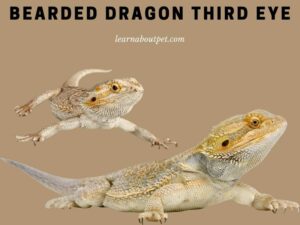
Of course, that’s assuming that you don’t already seem to be sitting on top of them. The bearded dragon third eye will perceive you as a threat to them, and of course, they will react because of it.
Bearded dragon vision is perfect for seeing things on the side because their eyes are directly on it. They can even see things outside the window even if they are far inside your house.
Indeed, bearded dragons can’t see things from the front like us because their eyes are turned to the side. But if you are close to them in front of them, you can still be seen by your dragon.
How Far Can A Bearded Dragon See?
You could say bearded dragon eyesight is excellent. In addition to seeing the whole from the side, bearded dragons can also see a little in front and behind them.
You can also test the bearded dragon vision range from placing food from afar. If they walked towards the food, then their eyesight was perfect.
This is true if bearded dragons are looking from the side because their eyes are on the side of their head. But if you try the bearded dragon vision from the front, it’s certainly not as good as when they look from the side.
Do bearded dragons have a third eye? Yes, the bearded dragon third eye is a light sensor to detect something in the upper part of its body.
Can Bearded Dragons See Color?
Many pet owners ask, do bearded dragons see color? Yes, even bearded dragons can see more colors than humans. This shows that bearded dragon vision is better in every respect compared to humans.
Bearded dragons have one more color conceptor than humans. This allows bearded dragons to see UV waves, indicating they need UV light for their metabolism.
This only applies to the two eyes on the side of the face, not the bearded dragon third eye. The pineal gland is only a sensor to see the light or shadow but cannot detect what color appears.
Are Bearded Dragons Color Blind?
It depends on which eye you mean. If you mean the bearded dragon third eye, then that’s correct because that gray spot acts as a sensor for light. But for the other two eyes, it’s not color blind.
Bearded dragon face front view can see light-colored objects better than darker colors. So they are more interested in anything that has a bright color rather than some object with a dark color.
Do bearded dragons have a third eye? Yes, but the third eye is not physically visible because it acts as a sensor.
Some things can be recognized when bearded dragons see something scary. They tend to turn black and hides because there’s something awful he’s seen. Check around them to see if anything is bothering them.
Can Bearded Dragons See At Night?
No, bearded dragons can’t see in the dark, neither can bearded dragons third eye. If bearded dragons are in a dark room, they are more likely to rest or sleep because they can produce hormones in the dark.
Do not turn on the UV light at night. Leave the room around the bearded dragons to remain dark so that the bearded dragon third eye can also rest. If there’s a shadow passing through or even the slightest bit of light, the third eye is still working, and this will interrupt your dragon’s rest time.
Because dragons have weak pupils, bearded dragon vision is quite bad in the dark. That’s why they prefer to hide and remain silent until there is a light that can make them see clearly again.
Why Does My Bearded Dragon Close One Eye?
Some bearded dragons will close their eyes on both sides for different reasons. This means you need to find out what is causing the behavior and take action.
One of the reasons why bearded dragons close one eye is to see more focus on one side of the eye. This happens if there is prey that will be ready for them to eat.
Bearded dragon third eye cannot be categorized as closed one eye because it does not include the main eye of bearded dragons.
Many other things can cause bearded dragon blind in one eye, including stress, substrate exposure, disease, poor diet, obesity, and inadequate lighting.
You cannot prevent the stress or the substrate or disease, but you can help your beardie calm down by providing a warm and moist environment. Providing proper lighting, a good diet, and regular basking are also important to keep your bearded dragon happy and healthy.
Bearded Dragon Eye Problems
In addition to discussing the bearded dragon parietal eye, we also have to understand some of the eye problems from bearded dragons to anticipate if this happens. The table below shows the common eye problems of bearded dragons.
| Eye problems | Explanation |
| Eye swollen | Can be a result from blocked tear ducts, tumor, or weakened blood vessels |
| Eye watering | Inflammation on the front layer of eye caused by virus or bacteria |
| Eye shedding | Shedding that remains around the eye |
| Eye Bulging | Skin loose around the eyelids when the skin is about to shed |
| Eye infection | Eye discharge due to viral or bacterial infections |
Immediately take your bearded dragons to the vet for a medical examination to ensure that they are not experiencing severe problems with their eyes. You can regularly clean the area around the bearded dragons’ eyes and make sure their eyes are always healthy without any issues.
Bearded Dragon Eye Care
Bearded dragons require far less eye care than they’re portrayed as needing. For one thing, it’s important to remember that bearded dragons are cold-blooded reptiles. Their eyes are simply on the sides of their heads. While the bearded dragon third eye does not need special care.
The first thing you need to remember is that you should only wash their eyes when necessary. You don’t need to scrub their eyes.
While you do want to gently wash their eyelids with warm water and a block of mild soap, you shouldn’t use a powerful solution or soap. You’ll also want to make sure that you rinse the key out of their eyes with lukewarm water as well.
Your bearded dragon is going to need a vet-prescribed liquid containing vitamins B & C, zinc, and magnesium. You should give him this daily, along with his vegetables.
Be sure that you give him a protein drink on the same day that he receives his liquid vitamins. This will help to speed up his healthy bearded dragon eyes.
Final Verdict On Bearded Dragon Third Eye
You need to know that bearded dragons have three eyes. The two prominent eyes are located on the side of their head, and one is above the skull, which is useful for the sense of the light to see any threats from above.

The pineal eye is a gray dot that is located right in the middle of the eye. This third eye cannot see the two real eyes but triggers hormone production that adjusts to the biological clock.
Bearded dragons have much better vision than humans. They can see great distances unless they see the front or back of them. Their eyes can also see colors that are much more complex than the human eye to see UV waves.
Make sure bearded dragon’s eyes stay healthy by caring for them the right way.

Welcome to Learn About Pet. My name is Rajkumar Ravichandran and I love all pets, travel, and amazing food. I write about my passion and personal experience caring for multiple pets in this blog! ❤️
Post Disclaimer
DISCLAIMER: THIS BLOG OR WEBSITE, "Learn About Pet", DOES NOT PROVIDE YOU WITH MEDICAL ADVICE AND IS NOT A SUBSTITUTE FOR MEDICAL ADVICE. ALWAYS GET IN TOUCH WITH YOUR PERSONAL VETERINARIAN AND USE INFORMATION HERE AS GENERAL ADVICE.
The information, including but not limited to, text, graphics, images and other material contained on this website are for informational purposes only. No material on this site is intended to be a substitute for professional veterinary advice, food recommendation, diagnosis, or treatment. Always seek the advice of your veterinarian or other qualified health care provider with any questions you may have regarding a medical condition or for pet food related questions.
